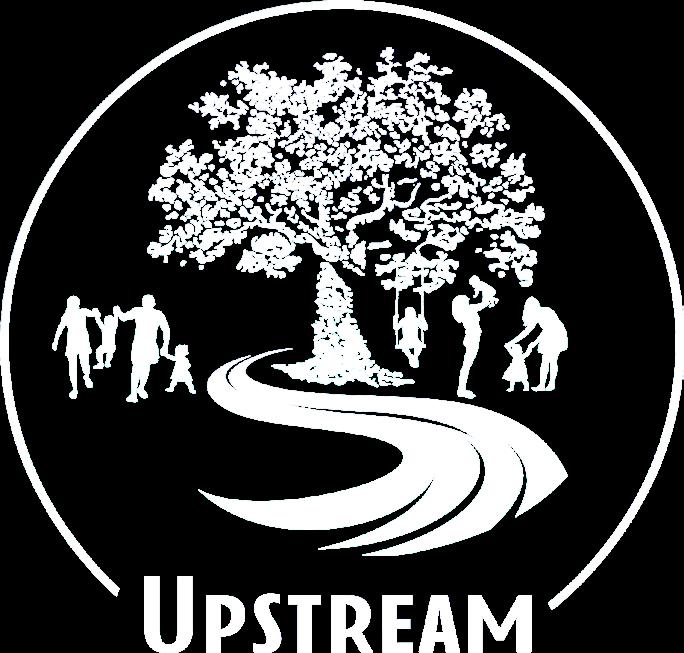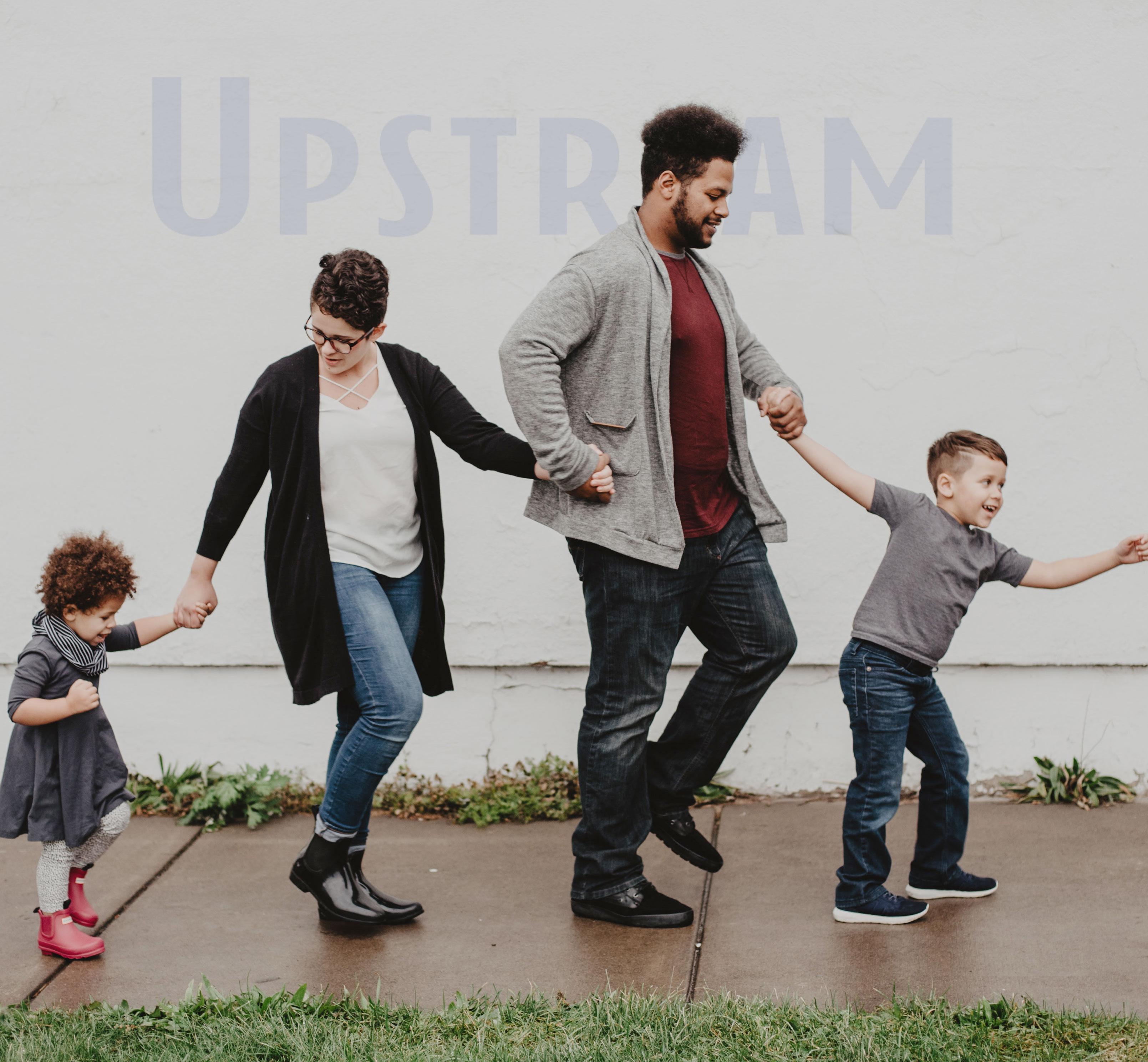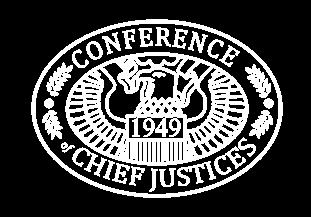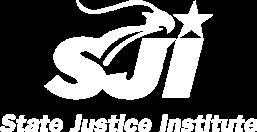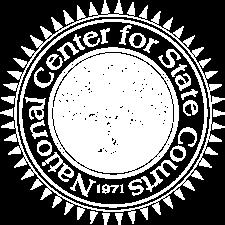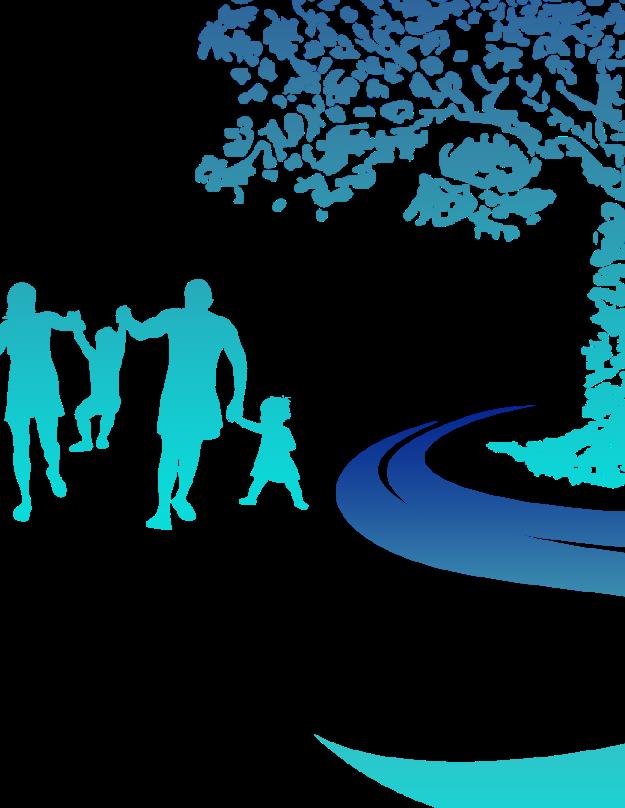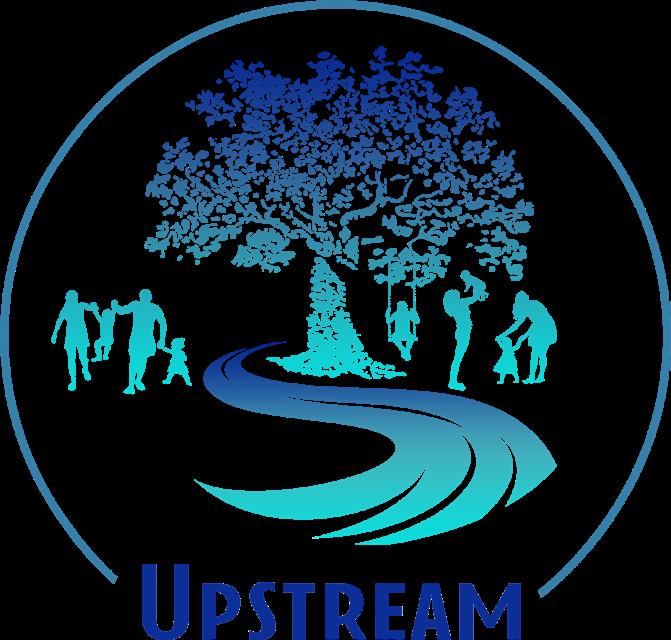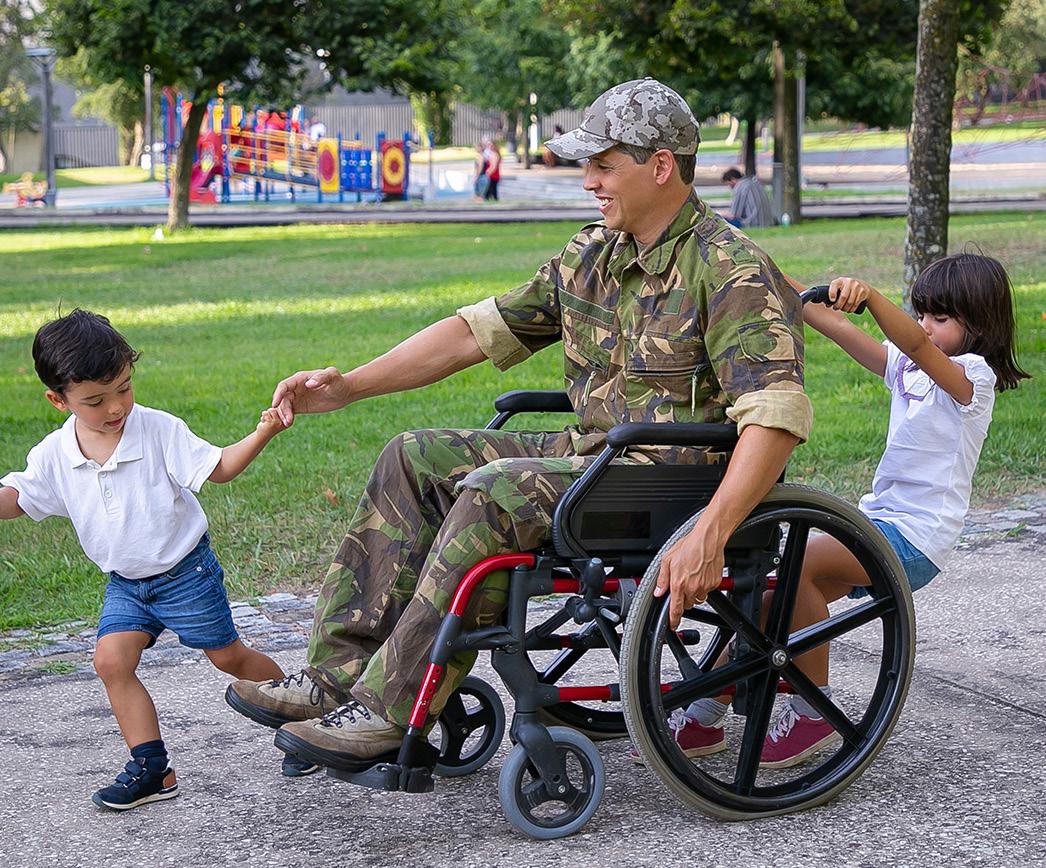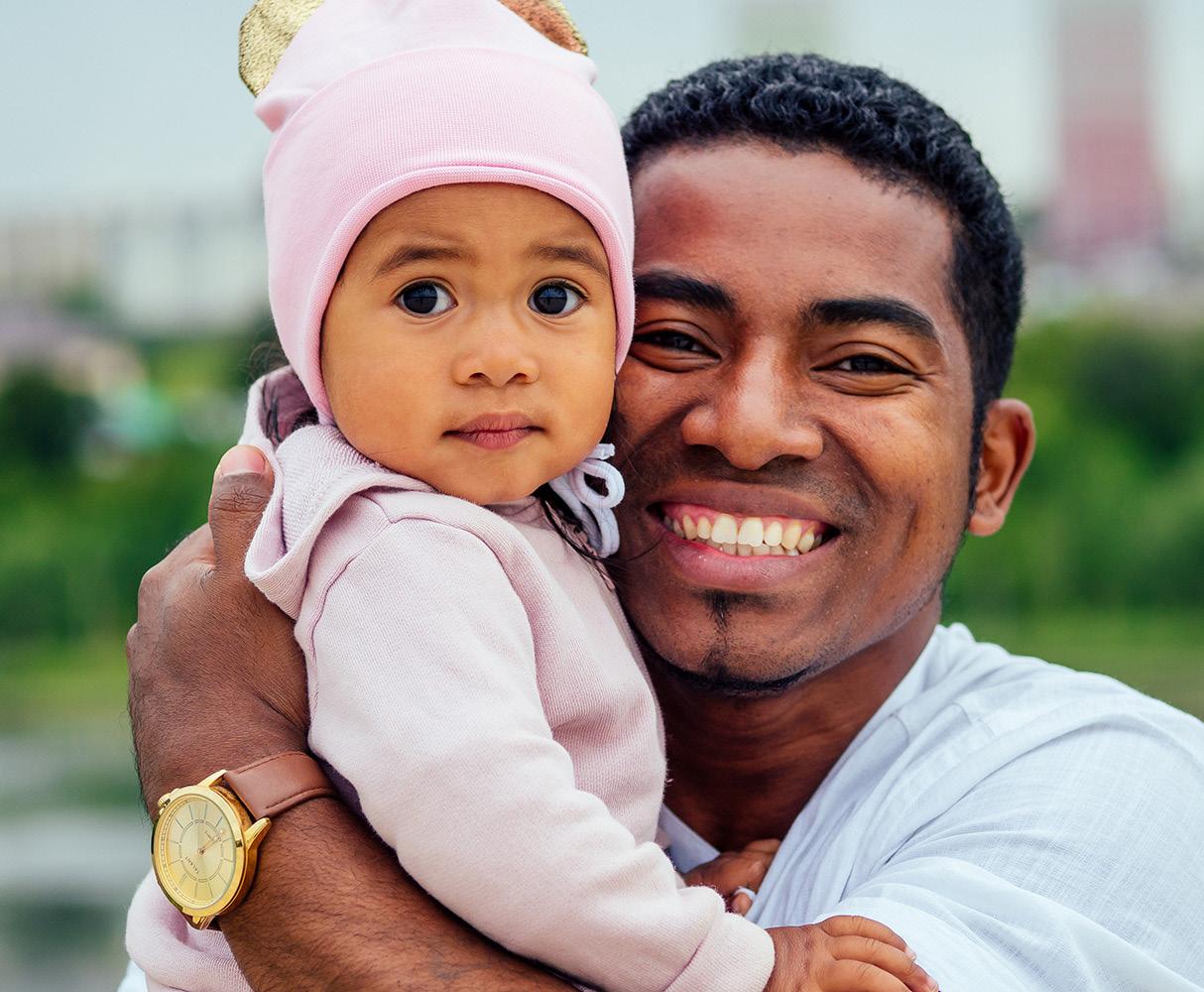UPSTREAM Guiding Principles

1. Everyone should have the opportunity to live in communities which support their basic needs to thrive.
2. The well-being of children and families is the responsibility of the entire community.

3. It is a fundamental right of individuals to parent their children, and families should be kept together safely whenever possible.
4. Judicial leadership at the state and local level can be a catalyst to drive positive systems’ changes.
5. Strength-based, trauma-informed, and high-quality communitybased services and supports that amplify family voice should be available and accessible to all families.
6. Services for families and children should be responsive to race, gender, ethnicity, socioeconomic status, sexual orientation, gender identity, faith, language, age, and developmental level.
7. Historical, personal, and systemic biases must be understood and addressed to ensure equitable responses to all.
8. Family supports should be individualized based on the families’ unique priorities, perspectives, and needs to ensure a safe, healthy, and thriving family.
9. Meaningful information sharing and case coordination supports positive outcomes for children and families.
10. Data collection, evaluation, and continuous quality improvement should be prioritized in planning, implementing, and sustaining a comprehensive community response.
6 GUIDING PRINCIPLES
Vision of Upstream
All families have access to community-based, coordinated, and comprehensive prevention and intervention networks that result in safe, stable, and nurturing homes.
Mission of Upstream
� Support data-driven, evidence-based, and culturally appropriate practices
� Facilitate and enhance collaboration and coordination among partners and across systems
� Reduce child maltreatment, family disruption, and trauma
Goals of Upstream
� Promote judicial leadership to convene stakeholders
� Support mapping workshop
� Enhance collaboration
� Implement change
Framework
The Upstream framework is inspired by the Sequential Intercept Model (SIM) and informed by the public health model of prevention, social determinants of health, and the risk and protective factors for child abuse and neglect. Each of these models is briefly described below. This framework is used to drive community discussions during the Local Mapping Workshops. The domains of Community, Families with Risk Factors, Families with Allegations of Abuse/Neglect, and Families with Court Involvement will be mapped. In addition, Community Collaborations, which are necessary to the process and ensuring change, should inform discussions at each domain and are defined in the Appendix.
• Safe and Affordable Housing
• Early Childhood Education
• Health Screenings
• Headstart
• Early Intervention
• Family Support Centers
FAMILIES WITH ALLEGATIONS
FAMILIES WITH COURT INVOLVEMENT
• Alternative Responses
• Voluntary Services
• Family Team Meetings
• Safety Planning
• High Quality Legal Representation

• Dependency Mediation
• Nurse-Family Partnerships
• Housing Supports
• Legal Aid
COMMUNITY EXAMPLES UPSTREAM DOMAINS OF PREVENTION & INTERVENTION COMMUNITY AFFORDABLE ACCESS
• Therapeutic Family Time
• Specialty Courts
RESOURCE COLLABORATION EQUITY INCLUSION SAFETY
• Pre-Post Reunification Services
PURPOSE 7
PURPOSE A comprehensive list of strategies and definitions which will be used during local community mapping are included in the Appendix.
FAMILIES WITH RISK FACTORS
Sequential Intercept Model1
The Sequential Intercept Model (SIM) is a conceptual model to inform community-based responses to the involvement of people with mental health and substance use disorders in the criminal justice system. SIM is an interactive, facilitated workshop to assist cities and counties in determining how people with mental health and substance use disorders flow from the community into the criminal justice system and eventually return to the community. During the mapping process, the community stakeholders

are introduced to evidence-based practices and emerging best practices from around the country. The culmination of the mapping process is the creation of a local strategic plan based on the gaps, resources, and priorities identified by community stakeholders. The mapping workshop is a means for promoting communitybased strategies to reduce the justice system involvement of people with mental health and substance use disorders.
https://store.samhsa.gov/sites/default/files/d7/priv/pep19-sim-brochure.pdf
8 8 1
PURPOSE
Public Health Model of Prevention2
According to the Children’s Bureau, prevention efforts are generally recognized as occurring along three levels: primary, secondary, and tertiary. The ideal approach to prevention encompasses all three levels, which results in a comprehensive service framework focused on improving outcomes for children and families.
� Primary prevention activities are directed at the general population and attempt to stop maltreatment before it occurs. All members of the community have access to and may benefit from these services. Primary prevention activities with a universal focus seek to raise the awareness of the general public, service providers, and decision-makers about the scope and problems associated with child maltreatment.
� Secondary prevention activities with a high-risk focus are offered to populations that have one or more risk factors associated with child maltreatment, such as poverty, parental substance abuse, young parental age, parental mental health concerns, and parental or child disabilities. Programs may target services for communities or neighborhoods that have a high incidence of any or all of these risk factors.
Adapted from the Child Welfare Information Gateway Framework for the Prevention of Child Maltreatment
Tertiary
Directed toward families in which maltreatment has occurred. [Family preservation, mental health services]
Directed toward families with one or more risk factors. [Home visitation, parent education, respite care]
Primary
Please see The Court’s Role in Prevention for more information.
� Tertiary prevention activities focus on families where maltreatment has already occurred (indicated) and seek to reduce the negative consequences of the maltreatment and to prevent its recurrence. 2
PURPOSE
7 9
Secondary
https://www.childwelfare.gov/topics/preventing/overview/framework/ Universal
Targeted
Levels of Prevention
Directed toward the general population. [Public awareness campaigns, parent education]
Social Determinants of Health3
Social determinants of health are the conditions in the environments where people are born, live, work, play, worship, and age that affect a wide range of health, functioning, and quality of life outcomes and risks. Healthy communities are essential for the health, vitality, and resilience of individuals and families. A lack of access to the social and structural determinants of health — and other stressors related to poverty — can undermine the well-being of children and families, increasing the likelihood that families will become involved in the child welfare system.4
There are five domains:
Economic Stability
The connection between the financial resources people have – income, cost of living, and socioeconomic status –and their health. This area includes key issues such as poverty, employment, food security, and housing stability.


Education Access and Quality
The connection of education to health and wellbeing. This domain includes key issues such as graduating from high school, enrollment in higher education, educational attainment in general, language and literacy, and early childhood education and development.

Neighborhood and Built Environment
The connection between where a person lives –housing, neighborhood, and environment – and their health and wellbeing. This includes topics like quality of housing, access to transportation, availability of healthy foods, air and water quality, and neighborhood crime and violence.
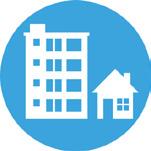
Health Care Access and Quality
The connection between people’s access to and understanding of health services and their own health. This domain includes key issues such as access to healthcare, access to primary care, health insurance coverage, and health literacy.

Social and Community Context
The connection between characteristics of the contexts within which people live, learn, work, and play, as well as their health and wellbeing. This includes topics like cohesion within a community, civic participation, discrimination, conditions in the workplace, and incarceration.
Please see the Social Determinants of Health for more information.
3 U.S. Department of Health and Human Services, https://health.gov/healthypeople/objectives-and-data/ social-determinants-health
4 Casey Family Programs, https://www.casey.org/sdoh-legal-advocacy/

108 PURPOSE
Supporting Equity for Children and Families
The demographic composition, resources, challenges, and cultural norms of a community distinguishes it from other communities, just as the experiences of individuals differ based on their identity, neighborhood, and access to opportunities. When a group of people in a community face adversity and conditions that make it difficult for them to thrive, the whole community is affected. The work of identifying root causes of this adversity is complex since multiple factors intersect at varying levels, such as the policy level where decisions about infrastructure and resource allocation are made and the interpersonal level where
people’s personal attitudes or beliefs impact how they interact with others. Inequities that cause disparities should be addressed by first understanding the community through available information, collectively identifying the community's shared ideals and values, and then collaboratively acting to eliminate inequities and establish conditions that support all residents thriving. When opinions differ or challenges related to attitudes, beliefs, or perspectives arise, communities should remain focused on the collective values that they hold and how division can prevent them from achieving positive outcomes for every member of the community.
Please see Supporting Equity for Children and Families for more information.
Risk and Protective Factors for Child Abuse and Neglect5
Child abuse and neglect are preventable. There are a number of factors that may increase the risk of child abuse or neglect and a number of factors that can decrease the risk or protect children from child abuse and neglect. The below lists are those provided by the Centers for Disease Control and Prevention and are not an exclusive list. Many of the social determinants of health are evident in the risk and protective factors for child abuse and neglect.
Risk Factors for Child Abuse and Neglect
Risk factors are characteristics that may increase the likelihood of experiencing or perpetrating child abuse and neglect, but they may or may not be direct causes. A combination of individual, relational, community, and societal factors contribute to the risk of child abuse and neglect.
5 Centers for Disease Control and Prevention, https://www.cdc.gov/violenceprevention/childabuseandneglect/ riskprotectivefactors.html
6 https://www.cdc.gov/violenceprevention/pdf/can/CAN-factsheet_508.pdfriskprotectivefactors.html
711
PURPOSE
that
increase the likelihood of
event. PROTECTIVE
RISK FACTORS Characteristics
may
experiencing a negative
FACTORS Characteristics associated with lower likelihood of negative outcomes or that reduce the impact of a risk factor.
Although children are not responsible for the harm inflicted upon them, certain factors have been found to increase their risk of being abused and/or neglected.6
� Children younger than 4 years of age or children with special needs that may increase caregiver burden (e.g., disabilities, mental health issues, and chronic physical illnesses)
� Caregivers with drug or alcohol issues or mental health needs (including depression)
� Caregivers who don’t understand children’s needs or development
� Caregivers who were abused or neglected as children
� Caregivers who are young or single parents or parents with many children
� Caregivers with low education or income
� Caregivers experiencing high levels of parenting and/or economic stress
� Caregivers who use spanking and other forms of corporal punishment for discipline
� Caregivers in the home who are not biological parents
� Caregivers with attitudes accepting of or justifying violence or aggression
� Families that have family members in jail or prison
� Families that are isolated from and not connected to other people (extended family, friends, neighbors)
� Family violence, including relationship violence

� Families with high conflict and negative communication styles
� Communities with high rates of violence and crime
� Communities with high rates of poverty and limited educational and economic opportunities
� Communities with high unemployment rates
� Communities with easy access to drugs and alcohol
� Communities where neighbors don’t know or look out for each other and there is low community involvement among residents
� Communities with few community activities for young people
� Communities with unstable housing and where residents move frequently
� Communities where families frequently experience food insecurity
128 PURPOSE
Protective Factors for Child Abuse and Neglect
Protective factors may lessen the likelihood of children being abused or neglected. Building or strengthening protective factors is equally as important as addressing risk factors.
� Caregivers who create safe, positive relationships with children
� Caregivers who practice nurturing parenting skills and provide emotional support
� Caregivers who can meet basic needs of food, shelter, education, and health services
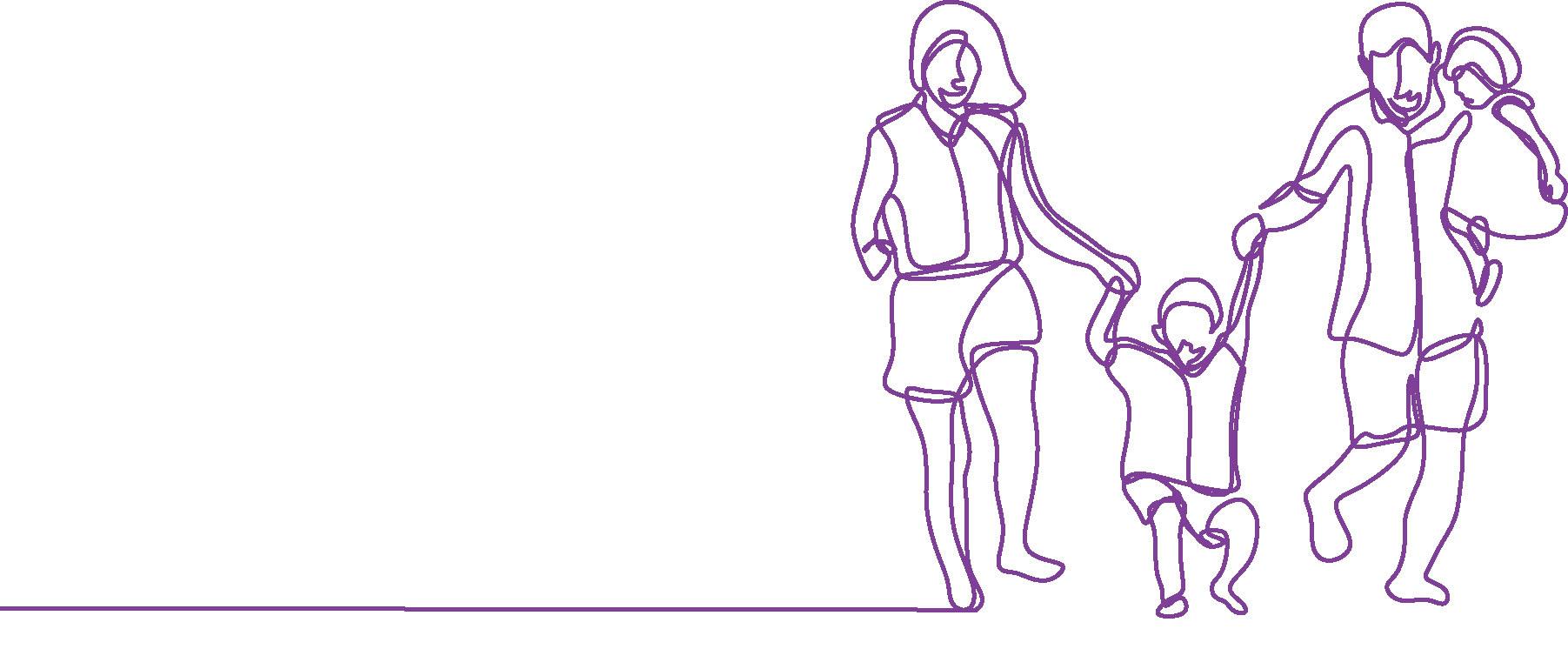
� Caregivers who have a college degree or higher and have steady employment
� Families with strong social support networks and stable, positive relationships with the people around them
� Families where caregivers are present and interested in the child
� Families where caregivers enforce household rules and engage in child monitoring
� Families with caring adults outside the family who can serve as role models or mentors
� Communities with access to safe, stable housing
� Communities where families have access to high-quality preschool
� Communities where families have access to nurturing and safe childcare
� Communities where families have access to safe, engaging afterschool programs and activities
� Communities where families have access to medical care and mental health services
� Communities where families have access to economic and financial help
� Communities where adults have work opportunities with family-friendly policies
Strengthening the social determinants of health and protective factors and addressing risk factors decreases possible child abuse and neglect and child welfare involvement. This responsibility belongs to the entire community. Multiple stakeholders must center the voices of those with lived experience
(please see The Value of Including Individuals with Lived Experience for more information) and identify community assets, analyze root causes, identify community indicators of health, identify community strengths and barriers, problem solve, co-create, and implement targeted place-based solutions.
The three phases of Upstream support states and local communities in these efforts through planning, local mapping workshops, and implementation support.
713
PURPOSE
The Upstream process weaves together knowledge of social determinants of health and risk and protective factors with research-based strategies for community engagement. Through coordination and planning, capacity building, facilitated mapping and action planning, and support for implementation, the Upstream process is designed to support positive outcomes for families.

Upstream Theory of Change
Courts commit to the Upstream process so that:
� Courts engage stakeholders in a shared vision of preventing maltreatment, out- of-home placement, and court involvement through community supports;
� Courts leverage court resources and judicial leadership to convene a broad range of stakeholders;
� Stakeholders collaborate to provide a structured process to local communities through trained facilitators;
� Community stakeholders share information on available resources and assess their capacity to support social determinants of health through a mapping workshop;
� Communities identify opportunities and co-create action plans to enhance the continuum of services and supports available to families to strengthen social determinants of health;
� Communities are better able to increase protective factors, improve community.conditions, and support healthy families; and
� There are fewer adverse childhood experiences, and children and families can thrive.
Upstream Model
The cornerstone of Upstream is state and local stakeholders supporting and engaging in community mapping and collaborative efforts. Community mapping is a structured process which brings together stakeholders to identify resources, opportunities, and priorities. The process elevates community voice, leverages existing partnerships and initiatives, and results in an action plan. During community mapping, stakeholders identify prevention and intervention strategies already in place, opportunities for improvement, and discuss current processes. After community mapping the stakeholders finalize an action plan to address gaps and implement change.
THEORY 14 THEORY
There are three phases of Upstream:
1. State Leadership Planning, Coordination, and Capacity Building - the state planning team identifies and addresses potential state and local barriers and plans for and informs facilitator training;
2. Training Facilitators to Conduct Local Mapping - national experts train facilitators to conduct local mapping workshops; and
3. Local Planning and Collaboration, Local Mapping Workshop, Action Planning, and Implementation - a local planning team identifies stakeholders to participate in the workshop, facilitators conduct the local mapping workshop, and stakeholders create and implement a local action plan.
The work described in the three phases and implementation can also be done by single jurisdictions without state coordination. The local planning team then assumes the tasks of the state planning team for the local jurisdiction, as appropriate.
Phases of Upstream
PHASE RESPONSIBLE PARTY TASKS
State Planning Team – Includes leaders from the court, child welfare agency, leaders from other organizations, and the voice of persons with lived experience
• Communicate to leadership about the goals of Upstream, planning process, and implementation plan for the state/locality.
State Leadership Planning, Coordination, and Capacity Building
Train Facilitators to Conduct Local Mapping Workshops
Local Planning and Collaboration, Local Mapping Workshop, Action Planning, and Implementation
State Planning Team, National Experts, and Facilitators
Trained Facilitators and Local Planning Team in coordination with State Planning Team
Local Planning Group –Convened with local judicial leader, in coordination with the child welfare agency and the workshop facilitators and includes local stakeholders, community resource leaders, and persons with lived experience
• Connect with local jurisdictions to describe Upstream and the plan for implementation.
• Provide assistance to local communities, monitor action plans, and continue to implement mappings in counties across the state/locality.
• Participate in facilitator training, develop skills to conduct local mapping workshops.
• Develop workshop participant list, conduct focus groups, inventory existing resources, and collect data.
• Conduct a workshop with local stakeholders to review risk and protective factors and data, review child welfare policies and practices, identify resources and opportunities, determine priorities, and develop an action plan.
1: 2: 3: IMPLEMENTATION
15
IMPLEMENTATION
• Compile and disseminate the report findings, convene monthly meetings to maintain momentum, and provide technical assistance to the community.
The three phases of Upstream support states and local communities in these efforts through planning, local mapping workshops, and implementation support.
Objectives of Mapping Workshop
� Develop a map of the child welfare system including domains of prevention and intervention
� Identify resources and gaps in practices, protocols, and programs
� Collectively agree on priorities for change
� Engage stakeholders and elevate community voice
� Develop an action plan to improve system and service-level responses
� Implement tenants of action plan and measure impact on outcomes
Implementation
Upstream is designed with an eye toward research-based strategies that increase the likelihood for successful implementation. Implementation science is the study of the strategies to promote the successful adoption and integration of practices and programs. Research in implementation science has rapidly expanded in recent years and has identified several components of capacity and infrastructure that drive successful implementation.
The Upstream process incorporates these implementation drivers, including:
� Cultivating leaders and champions
� Growing and sustaining interdisciplinary relationships
� Establishing shared vision
� Assessing needs and assets, and
� Tailoring supports
An Upstream State Planning Checklist and Local Planning Checklist help to guide teams through the tasks required to implement Upstream. The following section describes those tasks and provides some options for implementation.
The work described in the three phases and implementation can also be done by single jurisdictions without state coordination. The local planning team then assumes the tasks of the state planning team for the local jurisdiction, as appropriate.
148 IMPLEMENTATION
16
Identify a Chief Justice or Judge in a Leadership Position to Act as a State Champion and Convene Stakeholders
As with any effort, skilled leadership is critical to obtain buy-in, support the work, and sustain outcomes. Upstream must be led by someone with professional influence who understands the power of cross-system and community efforts and who has an intrinsic interest in developing safe and healthy families. Upstream calls for a judicial leader, such as a Chief Justice or a Judicial Officer in a leadership position, to act as a state champion. A long-touted benefit of judicial leadership is their ability to leverage their professional power to bring together stakeholders and build cross-system collaborations. This convening of stakeholders also promotes public confidence in the judiciary.
The role of the champion is to advocate for Upstream, build and leverage positive relationships with other statewide leaders, and drive the statewide vision forward through the State Planning Team. As the champion, the judicial leader may also be responsible for building bridges between organizational silos, aligning Upstream with other court-led efforts, and addressing barriers to implementation.
Identify and Assemble the State Planning Team
Upstream is designed to leverage judicial leadership; however, the court must also engage statewide partners from multiple agencies to be successful. In Upstream, those partners are brought together as the State Planning Team. The role of the State Planning Team is to develop, implement, and communicate a plan for how Upstream will be rolled out
in the local jurisdictions. This plan should be carefully constructed so that it aligns with other statewide efforts and is doable given available resources. The State Planning Team is expected to meet regularly, beginning at least 4 to 6 months prior to the Train the Trainer workshop. The State Planning Team should include the judicial champion as well as other state court leaders and leadership from the state child welfare agency. The other members may vary from state to state but should include representatives from other agencies and organizations that are involved in efforts to strengthen communities, such as the state departments of public health, behavioral health, and education. Members of the State Planning Team should be knowledgeable about similar statewide efforts, be informed of available resources, and have some decisionmaking ability. It can also be useful to have members who are aware of the unique needs of jurisdictions across the state; this may take the form of an individual from a state agency who delivers on-the-ground technical assistance to local communities or an individual who has lived experience in the child welfare system.
Develop Consensus as to the Anticipated Benefits of Participating in Upstream
One of the most important actions for the State Planning Team is to build relationships between entities. The individuals may or may not be familiar with each other on a personal level, but they will all walk into the room with preconceived notions about the agencies represented. Additionally, they may be faced with the limitation of previously existing silos between agencies or past tension or
717 IMPLEMENTATION
disagreement between agencies. To be effective, the State Planning Team needs to embrace the belief that all agencies are crucial and equal partners in strengthening families and communities, and the commitment of all partners is vital for success. By embracing this belief, the State Planning Team can develop and document a shared vision as to the anticipated benefits of participating in Upstream and description of how communities can be strengthened through the Upstream process. It is critical that the vision is co-created with all members of the State Planning Team to encourage commitment, demonstrate partnership, and enhance diversity of thought. This shared vision assists with communicating with other stakeholders about Upstream, informs expectations for how local communities will participate and be supported, and lays the foundation for performance measures and anticipated outcomes for evaluation.
From this shared vision, the State Planning Team can more easily identify other related statewide efforts and determine how best to communicate and align these efforts with Upstream. The State Planning Team is responsible for communicating the goals and anticipated benefits of Upstream to a variety of stakeholders, from other statewide agency representatives to members local communities. The State Planning Team should consider developing a succinct statement to describe the state’s vision for Upstream (i.e., an elevator pitch) so that the messaging is consistent regardless of who is sending or receiving it. This message should be aspirational and inspirational; stakeholders should be able to imagine the positive changes anticipated from commitment to the Upstream process.
Gather Available Data
The State Planning Team is also responsible for collecting and sharing data to describe related statewide efforts and identify needs and opportunities within the local communities. This can be accomplished by requesting that current related initiatives share any information they have on how the effort is going, including successes and barriers encountered, as well as formal data reports. These data may include indicators of social determinants of health, child welfare involvement, and legal and judicial data. There are several statewide indicators that provide an overall view of current functioning within the state, and often the indicators can be disaggregated by county or judicial district. See Using Data to Map Community Resources, Strengths, and Challenges: Data in Context for more information.
States may opt to document a process map that visually depicts the general steps involved in a family coming to the attention of the child welfare agency, coming to the attention of the court, and then transitioning to permanency. This process map should include decision points and options, entities responsible for making decisions, and any existing statewide policies that guide decisions. This exercise can help the State Planning Team identify opportunities for improvement, highlight conflicting policies and practices, and provide insight to how the state agencies can support the local communities in their Upstream Action Plans.
168 IMPLEMENTATION 18
Define Performance Measures and Outcomes
The shared vision and process map lay the foundation for performance and outcome measures that the State Planning Team can use to assess progress with implementing Upstream. Following Local Mapping Workshops, each community will identify unique priorities and develop action plans specific to those priorities and existing strengths and resources. Because communities will likely be focused on different goals and because there are other related efforts, it is challenging to attribute changes in statewide indicators to Upstream alone. Instead, the State Planning Team should focus on performance measures and short-term outcomes that describe how communities are implementing the Upstream process.
For example, the State Planning Team should determine how to track the number of facilitators trained and the number of Local Mapping Workshops. The State Planning Team should also request copies of the Local Action Plans so that they can be aware of the priorities in and across communities; this can assist the State Planning Team in identifying opportunities to provide additional support or assistance to the communities. The data collection plans should be determined early in the process so they can be communicated to Local Planning Teams.
Define the Expectations for the Local Planning Teams
The State Planning Team is responsible for determining how they will engage communities and support the Local Mapping Workshops and resulting Action Plans. There are several possible ways that the State Planning Team can choose to engage and support communities, and it is often useful to consider how past statewide initiatives have been implemented and discuss past successes and barriers. Specifically, the State Planning Team will want to determine a process to identify facilitators to be trained, how to decide which communities to engage, and how the state agencies will be involved in implementation and follow-up.
The State Planning Team will need to decide how to identify individuals to be trained as facilitators. It is beneficial to have two facilitators in each Local Mapping Workshop, with at least one with knowledge of the child welfare system. Good candidates for facilitators should be effective communicators, active listeners, able to remain objective, self-directed, and trustworthy. Ideally, individuals identified to be facilitators will have previous experience facilitating large groups, but group facilitation skills will also be covered in the Train the Trainer workshop. The State Planning Team can decide to train a small number of facilitators who will then be responsible for facilitating Local Mapping Workshops in multiple jurisdictions or to train several facilitators who already have a connection with the communities participating in the Local Mapping Workshops. If the state has a large and diverse geographic area to cover, it may be better to train multiple facilitators who have insights to the strengths and resources of the various communities. If the
719
IMPLEMENTATION
state is small and has the resources to support an individual who can focus on Upstream, training a few facilitators to travel statewide may be the best option. Similarly, if the state’s child welfare agency and/or courts are centrally administered at the state level, it may be logical to train a few statewide facilitators. On the other hand, if the system is largely locally administered, individuals from the communities who are knowledgeable of local practices and resources may be preferred. Finally, the State Planning Team should consider the resources available to them to support the individuals who will be facilitators of the Mapping Workshops. The facilitator training will take up to two days, and the facilitators will also be expected to assist the Local Planning Team in coordinating the Mapping Workshop, collecting preliminary data, and developing the resulting Action Plan.
During the Mapping Workshop, the facilitator will help the community develop an Action Plan. The State Planning Team needs to set expectations for how the state agencies will be involved in implementing, supporting, and monitoring the Action Plan. Some questions to consider are:
� What entity and/or individual in the local community should be expected to lead and manage implementation?
There may already be local community groups for whom the Action Plan integrates well into existing improvement plans. Alternatively, there may be the opportunity to leverage local judicial leadership to develop a group to work on the Action Plan. A third option would be for the facilitator identified by the State Planning Team to continue to work with the community on implementation; this option would require additional statewide resources, so the State
Planning Team should also discuss how long the support would be in place.
� Will the State Planning Team require reports from the communities on progress in their Action Plan?
If so, who will be responsible for the reports and what information will be required?
Suggestions for reporting items include description of progress on each task, notable successes and barriers, and what additional support is needed from the State Planning Team.
� What skills, resources, or connections do the State Planning Team have that can help support implementation and evaluation? All communities may not have the data and evaluation capacity or implementation and project management skills needed to support implementation of the Action Plan. Resources may come in the form of financial support for staffing or programs but can also come in the form of connections to staff member with specialized expertise or experts in the field from local universities or technical assistance organizations. The State Planning Team should identify what resources they can make available to the local communities and be transparent about the support they can offer following the Mapping Workshop.
One strategy for implementing multi-system, community change efforts is Collective Impact. Collective Impact is an intentional way that organizations, agencies, and stakeholders commit to working together through mutually reinforcing activities to address a complex issue. A primary component of Collective Impact is a Backbone Organization, an organization with staff dedicated to supporting the effort. It takes considerable
188
IMPLEMENTATION 20
time and resources to support a Collective Impact initiative, however, the strategy has been shown to be effective at creating conditions necessary for community change.
Introduce Stakeholders to Upstream
Once the State Planning Team has clearly defined their shared vision and expectations for participating local communities, they need to communicate their vision and expectations to other state leaders and to local communities. This can be accomplished through a stakeholder meeting where the State Planning Team describes their vision for Upstream and its anticipated benefits, outlines their plan for implementation, and shows how Upstream aligns with other state efforts.
Establish Local Planning Teams
There are multiple ways that communities can be identified to participate in Upstream, and the State Planning Team should consider how to best scale the effort given their resources. Communities can be invited to apply to participate, identified due to strong judicial or agency leadership, or selected due to opportunities for improvement detected in existing data.
Once a community has been identified as a participant, the State Planning Team needs to convene a Local Planning Team. The Local Planning Team’s primary responsibilities will be planning and coordinating the Mapping Workshop, collecting preliminary community level data, and convening regular meetings to implement the Action Plan. The Local Planning Team should begin meeting at least four to six months prior to the Mapping Workshop.
The Local Planning Team should absolutely include at least one of the facilitators identified by the State Mapping Team, local judges and court leadership, as well as agency leadership. These core members can help identify other members to include such as child welfare system professionals, treatment providers, representatives from education and healthcare, and individuals with lived experience in the child welfare system. It is important that the Local Planning Team represent the diversity of the community, and there should be efforts to include stakeholders who may not typically be invited to participate in planning and coordination. See The Value of Including Individuals with Lived Experience for more information.
Similar to the process the State Planning Team completed, the Local Planning Team must also develop a shared vision for how they see Upstream benefitting their community. This vision may be similar to the state’s vision, but the Local Planning Team may add specific details acknowledging the existing strengths in their community and describing the changes they hope to see in their community. Establishing a local vision is important to demonstrate that members of the Local Planning Team agree that there is a need to strengthen proactive approaches to supporting children and families in the community and agree all stakeholders must work together to be effective. This shared belief is critical to the community’s level of readiness for change. Low levels of readiness can be a barrier to implementing change.
721
IMPLEMENTATION
Preparing for Local Mapping Workshop
The Local Planning Team will need to accomplish several tasks in preparation for the Mapping Workshop, including setting the workshop date and location, developing a list of invitees, and compiling data. There is a checklist for Local Planning Team that outlines specific tasks to follow to prepare for the Local Mapping Workshop.
The Mapping Workshop can be held virtually or in-person, and considerations for each option are described in the Facilitation Guide. It is recommended that a save-the-date announcement be sent to participants at least three months prior to the workshop, and registration information be sent to participants at least two months prior to the workshop. The invitee list should be large enough to include a variety of perspectives, though still be manageable for the facilitator to ensure all voices are heard.
Aside from the logistics in preparation for the Mapping Workshop, the Local Planning Team is also responsible for compiling different types of data to provide a current picture of the community. The information compiled should be discussed within the Local Planning Team in preparation for the Mapping Workshop and shared with the participants in the Mapping Workshop. The trained facilitator will be prepared to assist with this effort, and technical assistance is available.
� The Community Assessment is a survey to be sent to key community stakeholders, including those invited to the Mapping Workshop. It collects stakeholder perceptions regarding the community’s access to services and level of collaboration
among partners. This information can be used to identify strengths and limitations to highlight during the Mapping Workshop. This tool can also be sent out months after the Mapping Workshop to assess change.
� The trained facilitator will also be prepared to facilitate focus groups and interviews with key stakeholders to supplement the information collected in the Community Assessment. The focus groups can also be a good way to include individuals who are not able to attend the Mapping Workshop, front-line workers who have a unique view of how the system functions, and those with lived experience who may not feel comfortable in the larger Mapping Workshop.
� The Local Planning Team will also be asked to bring existing data from administrative data or agency reports that describe the local community. The State Planning Team can be a support here, as they will have gathered similar data from the statewide perspective. Examples of indicators of interest include population of children in the community by race, percent of children living in poverty, percent of families experiencing food or housing insecurity by race, graduation rates over time and by race, confirmed reports of maltreatment by race, number of children entering and exiting foster care, and dependency court performance measures. See Using Data to Map Community Resources, Strengths, and Challenges: Data in Context for a description of potential indicators and data sources. There is technical assistance available to assist with compiling this data.
208
22 IMPLEMENTATION
Implementation and Evaluation of Local Efforts
Oversight of implementation of the Action Plan and evaluation of efforts is an area where the State Planning Team and Local Planning Team will need to determine roles. As discussed, the State Planning Team will have previously communicated to the Local Planning Team what resources are available to support oversight and evaluation. Prior to the Mapping Workshop, the Local Planning Team will need to determine their plan to monitor implementation of the Action Plan, including how often they will meet and who will be responsible for convening the meetings. They can consider whether to connect this work to existing community efforts or to develop a new working group. There might be a need for additional support by way of new partnerships or requesting technical assistance.
Part of this oversight responsibility is evaluating implementation, so there should be members of the Local Planning Team who are knowledgeable on how to develop meaningful measures and collect data. The Local Planning Team should determine what data are important to collect and measure to reflect progress on their Action Plan and identify which agencies will be responsible for collecting the data and reporting it to the Team. Technical assistance is available to Upstream participants. Local Planning Teams should plan to track progress on the Action Plan over time; how many new agreements, policies, or programs have been implemented related to the Action Plan; to what extent are the policies and programs implemented with fidelity; and the immediate and long-term changes associated with new policies and programs. In addition, the Local Planning Team should reflect on drivers and barriers to implementation and share that information with the State Planning Team to inform future efforts.
Conclusion
The Upstream process weaves together knowledge of social determinants of health, risk and protective factors, and research-based strategies for community engagement. The domains of Upstream guide and focus discussions for mapping the local community landscape. Through coordination and planning, capacity building, facilitated mapping and action planning, and support for implementation, the Upstream process is designed to support positive outcomes for communities, children, and families.
Courts are in an ideal position to lead state and local efforts for convening communities toward the shared vision of Upstream. Upstream is intended to support court leadership to guide coordinated and collaborative community discussions that result in a more effective and preventionfocused system. This approach aims to reduce child maltreatment, out of home placement, and minimize court involvement.
723
IMPLEMENTATION
APPENDIX
UPSTREAM DOMAINS OF PREVENTION & INTERVENTION PROCESS MAP
The Upstream process weaves together knowledge of social determinants of health and risk and protective factors with research-based strategies for community engagement. Through coordination and planning, capacity building, facilitated mapping and action planning, and support for implementation, the Upstream process is designed to support positive outcomes for families.
UPSTREAM DOMAINS OF PREVENTION & INTERVENTION PROCESS MAP
COMMUNITY
RESOURCES AND SUPPORTS EVERY FAMILY NEEDS TO THRIVE
Economic StabilityNeighborhood and Built Environment
Equitable Treatment Under the Law Education Access and Quality Healthcare Access and Quality Social and Community Context
FAMILIES WITH RISK FACTORS
RESOURCES AND SUPPORTS TARGETED AT FAMILIES WITH ONE OR MORE CHARACTERISTICS ASSOCIATED WITH NEGATIVE OUTCOMES
Families with Risk Factors Identified Referral to Services
Reporting Allegations
FAMILIES WITH ALLEGATIONS
RESOURCES AND PROCESSES TO RESPOND TO ALLEGATIONS OF ABUSE AND/OR NEGLECT
Screening In/Out Investigation
Intervention Services Service Assessments
Referral to Court
FAMILIES WITH COURT INVOLVEMENT
RESOURCES AND PROCESSES TO SUPPORT SAFETY, PERMANENCY, AND WELL-BEING AND PROMOTE POSITIVE OUTCOMES FOR CHILDREN AND FAMILIES
Petition/ Shel ter Care
Review Hearings
Adjudication/ Disposition
COMMUNITY
Establishing Permanency
RESOURCE EXAMPLES
• Safe and Affordable Housing
• Early Childhood Education
• Health Screenings
• Headstart
• Early Intervention
• Family Support Centers
• Nurse-Family Partnerships
• Housing Supports
• Legal Aid
• Alternative Responses
• Voluntary Services
• Family Team Meetings
• Safety Planning
• High Quality Legal Representation
• Dependency Mediation
• Therapeutic Family Time
• Specialty Courts
• Pre-Post Reunification Services
228 APPENDIX 24
Strategies
The Upstream framework below lists examples of prevention and intervention strategies within each domain. The strategies may be relevant across multiple domains but are listed within the domain where they most frequently occur. The
listed strategies are also meant to be a starting point and leave space for community discussions on homegrown strategies. The Guiding Principles and Upstream framework provide the structure for community mapping.
Key Topics and Considerations for Each Domain
These are suggested topics for discussion and not an inclusive list.
COMMUNITY RESOURCES AND SUPPORTS EVERY FAMILY NEEDS TO THRIVE
Economic Stability
� Sustainable employment
� Financial stability
� Financial institutions
� Employment agencies
� Career exploration programs
� Job coaches
� Vocational training programs
� Availability of sustainable employment
Education Access and Quality
� Quality and affordable education
� Early education programs
� Programs and resources within schools
� Community colleges
� Mental health services and referrals in school
� Afterschool programming
� Tutoring
� Programming for students with disabilities
� Extra-curricular activities
Healthcare Access and Quality
� Quality and affordable healthcare
� Quality and affordable health insurance
� Health screenings
� Screening and assessment for trauma
� Various healthcare facilities
� Various levels of care
� Certified community behavioral health clinics
� Integrated healthcare clinics
� Emergency behavioral health services and acute treatment
� Mobile crisis services
� School-based healthcare clinics
� Social workers
� Medical legal partnerships
725 APPENDIX
S
DOH (Social Determinants of Health) EXPECTATIONS STRATEGIES
(Social Determinants of Health) EXPECTATIONS
Neighborhood and Built Environment
� Quality and affordable nutrition
� Accessible and affordable transportation
� Safe communities
� Available community spaces
� Connectivity
Social and Community Context
� Safe and affordable housing
� Quality and affordable childcare
� Connections and activities
Equitable Treatment Under the Law
� Self-advocacy
� Access to legal advocacy
� Access to legal services
� Access to justice
STRATEGIES
� Availability of public transportation
� Safe public spaces
� Parks and green spaces
� Community centers
� Technology availability
� Recreational activities
� Public service announcements and campaigns
� Various types of housing
� Available childcare
� Affordable childcare
� Summer camps
� Mentoring programs
� Parenting education
� Heath education
� Youth groups and activities
� Community events and activities
� Safe visitation and drop-off centers
� Preventative legal services
� Legal clinics in schools
� Court interpreters
� Self-help centers in courts
After considering each domain, reflect on if there are other resources that were not discussed or challenges that were not mentioned that should be included.
248 APPENDIX 26
)
COMMUNITY ( CONT.
S DOH
FAMILIES WITH RISK FACTORS
RESOURCES AND SUPPORTS TARGETED AT FAMILIES WITH ONE OR MORE CHARACTERISTIC ASSO CIATED WITH NEGATIVE OUTCOMES
S DOH (Social Determinants of Health)
Economic Stability
� Access to government benefits
STRATEGIES
� Support for obtaining government benefits
� Financial literacy training
� Job readiness training
� Employment supports for obtaining and retaining employment
Education Access and Quality
� Early family literacy centers
� GED programs
� Programs for students at risk of dropping out
� Early intervention for childhood development
� Early Headstart and Headstart
� Elevated mental health services in schools
� Educators are trained in identifying abuse and neglect risk factors
� Alternative education
Healthcare Access and Quality
� Providers who are trained in identifying abuse and neglect risk factors
� Providers who are trained in identifying domestic violence
� Providers who are knowledgeable about supports for suspected domestic violence
� Providers who are knowledgeable about supports for suspected abuse or neglect
� Social workers in medical facilities
� Subsidized prenatal care
� Medicaid accepted providers
� Emergency mental health treatment for youth and adults
� Home visitor programs for expecting and new mothers
� Mobile crisis services
� Uninsured/underinsured available services
� Treatment for survivors of interpersonal violence
� Peer network/navigator programs focused on mental health conditions and substance use disorders
� Different levels of mental health treatment (acute treatment, clinical stabilizations, residential treatment, outpatient treatment, recovery support)
� Post-adoption crisis intervention services
727 APPENDIX
S DOH
(Social Determinants of Health)
Neighborhood and Built Environment
FAMILIES WITH RISK FACTORS ( CONT. )
� Housing assistance
� Homeless shelters
� Food banks and pantries
� State nutrition assistance
Social and Community Context
Equitable Treatment Under the Law
STRATEGIES
� Programs at local parks/community centers for children and youth
� Parent support groups
� Teen parenting programs
� Grief services
� Supports for families with critical illness
� Family resource centers that offer information and referral services
� ALANON
� Groups for children whose parents are incarcerated
� Non-traditional family supports, including grandparents and other kin and friends/neighbors
� Legal aid agency
� Public defenders
� Civil defenders
� Domestic violence advocacy
� Civil commitment proceedings
� Guardianship options with assistance
After considering each domain, reflect on if there are other resources that were not discussed or challenges that were not mentioned that should be included.
FAMILIES WITH ALLEGATIONS OF ABUSE AND NEGLECT RESOURCES AND PROCESSES TO RESPOND TO ALLEGATIONS OF ABUSE AND/OR NEGLECT
S DOH
(Social Determinants of Health)
Economic Stability
Education Access and Quality
STRATEGIES
� See strategies from Families with Risk Factors
� Tutoring support for children/youth who missed large amounts of school
APPENDIX 28
FAMILIES WITH ALLEGATIONS OF ABUSE AND NEGLECT ( CONT. ) S DOH
(Social Determinants of Health)
Healthcare Access and Quality
Neighborhood and Built Environment
Social and Community Context
Equitable Treatment Under the Law
STRATEGIES
� Screening and assessment for mental health, trauma, and substance use (where not already treating)
� Substance use services for all types of addictions
� Different levels of substance use services (detox, outpatient, inpatient, medication-assisted treatment, support groups, recovery support)
� Parent education programs within substance abuse treatment programs
� Intensive family preservation services with trained mental health counselors available
� Psychiatric services and case managers
� Trauma therapy
� Sexual assault supports and services
� Domestic violence victim therapy
� Domestic violence batterer programs/therapy
� Anger management programs
� See strategies from Families with Risk Factors
� Emergency shelters and housing
� Homeless shelters
� Domestic violence shelters
� Runaway/homeless youth
� Shelters accept family placements
� Shelters provide respite placements
� Placements inclusive of transgender and gender nonconforming individuals
� Supports for transitioning from emergency housing
� Transportation for children to school from shelters
� Victim-based programs and services
� Respite care
� Parenting education
� Family team meetings
� Safety plans that keep children in their home
� Orders of protection
� Preventative legal advocacy
� Pre-petition programs
After considering each domain, reflect on if there are other resources that were not discussed or challenges that were not mentioned that should be included.
729 APPENDIX
FAMILIES WITH COURT INVOLVEMENT
RESOURCES AND PROCESSES TO SUPPORT SAFETY, PERMANENCY, AND WELL - BEING AND PROMOTE POSITIVE OUTCOMES FOR CHILDREN AND FAMILIES
S DOH (Social Determinants of Health) STRATEGIES
Economic Stability
Education Access and Quality
Healthcare Access and Quality
� See strategies from Families with Risk Factors
� Support for educational stability
� Support for classroom re-integration after separation due to foster care
� Specialized mental health treatment for adolescents
� Coordinated case plans
� Court-based services coordinator
Neighborhood and Built Environment
Social and Community Context
� See strategies from Families with Risk Factors
� Parent Partner
� Support and subsidies for relative foster care
� Foster parents as parental mentors/supports
� Ice Breakers
� Therapeutic foster care providers
� Group home care
� Residential programs for adolescents
� Programs and technology to support active engagement of incarcerated parents in case conferencing, identifying kin, and permanency planning
� Pre- and post-reunification services
� Exit planning including safety plans
� Respite services post-reunification
Equitable Treatment Under the Law
� Judicial oversight of in-home cases
� Legal representation at the first court appearance
� Appropriate payment structures for attorneys
� Interpreters
� Teen spaces
� Children’s centers
� Court-Appointed Special Advocates/GAL Programs
� Coordinated court responses
� One Family One Judge
� Multidisciplinary representation
� Case conferencing
� Post-dispositional reviews
� Post-reunification reviews
248 APPENDIX 26 30
Equitable Treatment Under the Law (cont.)
� Dependency mediations
� Models of supervised and therapeutic visitation
� Family treatment court or dependency court
� Infant and toddler courts, 0–3, safe baby courts
� Integrated domestic violence courts
� Mental health courts
� Virtual hearing protocols and technology
� Services within court houses
� Victims’ advocates available for court appearances
� Post-permanency planning and reentry prevention planning
After considering each domain, reflect on if there are other resources that were not discussed or challenges that were not mentioned that should be included.
DEFINITIONS
COMMUNITY What Everyone Needs to Thrive
ECONOMIC STABILITY
Sustainable Employment Communities have sufficient numbers of jobs available and accessible for all skill levels that provide opportunities for steady, ongoing work at wages that allow for self-sufficiency.
Financial Stability Individuals have a reliable source of income to have the ability to have all basic needs met/bills paid and are resilient to economic shock.
EDUCATION ACCESS AND QUALITY
Quality and Available Education
Communities have a variety of educational opportunities that provide equitable options and opportunities to help students of all ages achieve, regardless of zip code, including access to reliable internet for outof-school learning.
HEALTHCARE ACCESS AND QUALITY
Quality and Affordable Healthcare
Communities have sufficient numbers of options for health care providers at all levels of care including preventative, emergency, primary, and specialty, which accept Medicaid and other forms of low-cost insurance programs.
Quality and Affordable Health Insurance
Individuals have access to and support for enrollment in a variety of health insurance programs including Medicaid and other forms of income sensitive insurance.
731 APPENDIX
FAMILIES WITH COURT INVOLVEMENT ( CONT. ) S DOH (Social Determinants of Health) STRATEGIES
NEIGHBORHOOD AND BUILT ENVIRONMENT
Quality and Affordable Nutrition Communities have access to healthy and reasonably priced food options and strategies in place to educate individuals about healthy eating.
Accessible and Affordable Transportation Communities have multiple low-cost modes of transportation to allow all individuals to safely travel from their homes to areas of work, school, social events, shopping, and other necessary activities.
Safe Communities Communities promote health and safety and are free from violence and health hazards such as secondhand smoke, pollution and toxins and have available safe parks and recreation
Available Community Spaces Communities maintain safe places such as parks, libraries, museums, and community centers which enrich the lives of individuals in the community.
Connectivity Communities have the technological infrastructure to support telecommunications and internet access for all individuals.
SOCIAL AND COMMUNITY CONTEXT
Safe and Affordable Housing Communities have options for all persons that allows individuals, after paying housing cost, enough money for necessities like food, health care, and transportation and which provides a secure environment for families.
Quality and Affordable Childcare Communities have certified childcare available for all income levels and at varied hours and schedules to meet the needs of working families.
Connections and Activities Communities provide opportunities for individuals to develop a supportive social network of families, friends, co-workers, and community members including opportunities for young people to be engaged in recreational and skill building activities.
EQUITABLE TREATMENT UNDER THE LAW
Access to Justice Individuals facing legal issues have timely and affordable access to the level of legal help they need to be heard, receive a fair outcome on the merits of their legal issue, and a belief they were treated fairly in the process.
Access to Legal Advocacy Communities have sufficient legal assistance/legal representation (including pro bono and legal aid) so that no one faces court or legal conflict without legal help.
Access to Legal Services Individuals can utilize courts and legal information through multiple means including self-help services, court navigators, online forms and resources, and referrals to social services and attorneys who serve all income levels.
Self-Advocacy Individuals are included in decisions that impact their life and the lives of their family members as well as system improvement efforts and feel empowered to voice their needs and perspectives.
APPENDIX 32
